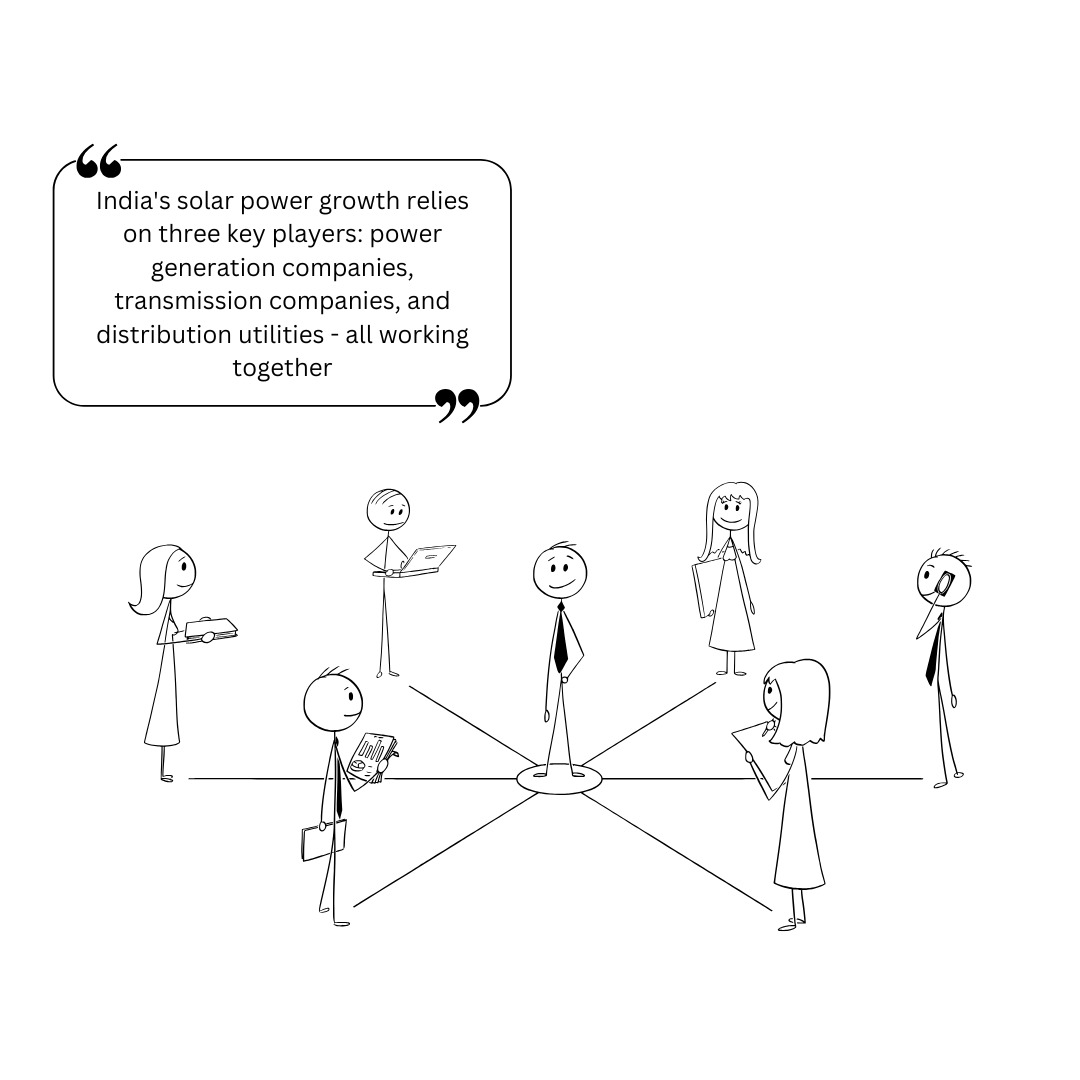Themes in this post: Power generation | Power transmission | Power distribution
The entire value chain of power generation to electricity reaching your home or company has three stages:
- Power generation
- Power transmission
- Power distribution
Power generation sector is easy to understand – just think of the large coal power plant you would have seen sometime in your life. Yep, power gen companies were mostly comprised of thermal power plants, and to a lesser extent by hydro and nuclear power plants in India, until of course solar came knocking.
Power distribution sector is easy to understand as well – it comprises companies that finally deliver the electricity to your home and to whom you pay your bills.
What about power transmission?
Well, you may not be able to relate to the transmission stage of the electricity value chain because you rarely see this part of the power sector. Transmission refers to long distance transport of electricity. Let’s take the example of India’s largest thermal power plant, the Vidyanchal Thermal Power Station in Singrauli, Madhya Pradesh, owned and operated by NTPC, with a capacity of about 4700 MW. Electricity from this power station will be supplying to many parts of the Singrauli district, which has a total area of about 5700 sq km. An electron produced at this plant could be travelling to a factory located well over a 100 Kms.
While the “last mile” of the electricity is delivered by the distribution company, who will take care of the transport of electricity from the power plant until the last mile? This is where transmission companies, with their long overhead transmission cables you would see while travelling by train or car on a highway, make an entry.
Thus it is that India’s electricity sector is currently dominated by the triumvirate of Generation, Transmission and Distribution companies. Some companies operate in both the production and distribution parts of the value chain. For instance, TANGEDO in Tamil Nadu both produces and distributes electricity. Transmission companies usually are pureplay firms, given the nature of work in this part of the value chain.
All these companies play a key role in the growth of solar power, so let’s see how the picture looks.
Power generation companies
Conventional power utility firms belonging to both central and state governments, and private sectors, have been participating in India’s solar power sector growth
Conventional power generation companies are those that have been generating power from – usually non-renewable – mostly coal, but a few from natural gas. Until a couple of decades back, almost power generation was done government (central or state) owned companies. But now, we have a number of private players such as Tata, Adani, Torrent etc.
With the arrival of solar power, almost every prominent conventional power generation firm has started investing heavily in it. Prominent among these include NTPC Limited, which has established over 2.5 GW of solar capacity, Adani Power through the group’s renewable energy arm Adani Green that is setting ambitious solar power targets, Tata Power, whose renewable energy capacity is over 5 GW, and companies such as JSW Energy that are also making serious investments into solar power plants. Conventional power generation companies in non-fossil sector such as SJVN (Satluj Jal Vidyut Nigam) and NHPC, both of which are prominent hydro-power companies have also invested in or plans to invest in solar power plants.
Distribution utilities
The distribution companies (discoms) play a key role in enabling access to solar power sector for the various end user segments
The distribution part of power generation is the one you and I see – these are the companies that finally distribute the power to consumers and collect the bills.
Discoms (short for distribution companies) are thus the face of electricity utilities in India, as they are in the rest of the world. For over a century, they had been cocooned in a conservative and protected environment, as the country’s reliance on conventional power sources secured their dominance. But as the world moves to renewables, especially solar, the discoms are realizing that they have to get their act together, and fast.
Many government discoms in India operate at a financial loss due to outdated tariff structures, high operational costs, and significant technical and commercial losses. Estimates suggest that Indian government-owned discoms have collectively accumulated losses of around about ₹7 lakh crores. Such massive financial instability affects their ability to invest in new technologies, including the integration of solar power.
Regardless of their current status and challenges, the old discoms will be a critical part of the renewable power sector for quite a while to come as they control the last mile of the electricity ecosystem in India. Even if rooftop solar generates and provides electricity on the premises, a large part of the country will rely on the grid for their power needs, and the #Hlast mile of the grid is in their hands#H.
All the above make for the Indian discom market a rather interesting one to view from the solar power prism.
So far, the discoms have had a rather challenging relationship with solar power firms because they are eating a good part of their breakfast, lunch and dinner. Distribution companies especially look at distributed solar power generation with real concern. And so they should – if I’m generating solar power right on rooftop, I do not need a distribution company! Their #Hcore business is in jeopardy#H wherever distributed solar power plants generate a significant portion of electricity consumed on the premises.
It should thus be no surprise that the discoms are worried about solar power, especially distributed solar power.
But well, they are seeing the writing on the wall, and recognize that distributed solar will continue growing and will eat into at least a portion of their revenues. So, they are finetuning their strategies to figure how best to become a part of the solar power movement.
Transmission companies
Transmission companies will play a key role in the scaling of India’s solar power sector, especially for inter-state transmission of solar power
Transmission companies, including both national and state-level utilities, are crucial to the success of solar energy projects in India. These companies are responsible for providing the necessary transmission infrastructure to carry solar energy from generation points (solar parks) to distribution networks that deliver power to consumers. They are the ones that are needed to ensure that solar power is reliably integrated into the grid without causing disruptions. This involves balancing the intermittent nature of solar power with the need for consistent supply.
Power Grid Corporation of India Limited (PGCIL) is the national transmission utility and the largest power transmission company in India. It owns and operates more than 1,50,000 circuit kilometers of transmission lines and about 250 substations, making it the backbone of the country’s power transmission network. The company plays a critical role in integrating renewable energy sources, particularly solar power, into the national grid. PGCIL is also heavily involved in the development of #HGreen Energy Corridors#H, which aim to enhance the transmission infrastructure to absorb and distribute renewable energy, including solar power. The National Green Energy Corridor (NGEC) project is a key initiative where PGCIL is responsible for constructing high-voltage transmission lines to connect renewable energy zones to the national grid.
Some of the prominent private power transmission companies in India include Adani Transmission Limited, Tata Power Transmission, JSW Energy and Sterlite Power Transmission.
India also has several state transmission utilities, each of which manages the power transmission within its respective state. These utilities play an essential role in solar integration by connecting solar parks to local distribution networks and ensuring the effective transmission of solar energy. Some prominent utilities include Maharashtra State Electricity Transmission Company Limited (MSETCL), Tamil Nadu Transmission Corporation (TANTRANSCO), Rajasthan Rajya Vidyut Prasaran Nigam Limited (RRVPNL), and Gujarat Energy Transmission Corporation Limited (GETCO). These state transmission companies manage the integration of solar energy into regional grids, balancing supply and demand by ensuring that solar generation can be effectively transmitted to local discoms.
Transmission companies are investing in advanced technologies such as high-voltage direct current (HVDC) lines and smart grids to ensure that solar power can be transmitted efficiently over long distances. Ongoing modernization efforts aim to improve grid resilience and integrate solar energy more effectively by enhancing grid flexibility, reducing losses, and enabling better forecasting and real-time management of solar generation. Transmission companies are also enhancing inter-regional transmission to enable states with high solar potential (e.g., Rajasthan, Gujarat) to export solar power to regions with high demand, thus facilitating solar energy adoption across India.
Reports suggest that the capex for India’s green energy transmission lines could double to Rs 1 lakh crores over financial years 2026 & 27 – this was about Rs 50000 crores for FY 2024 & 2025.
 Skip to content
Skip to content



